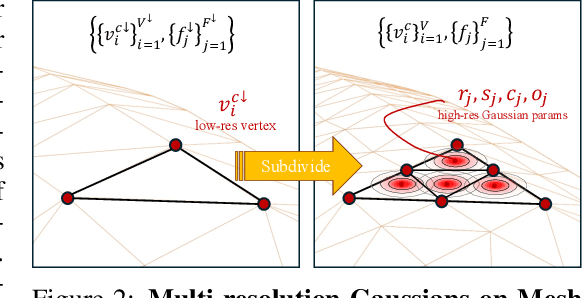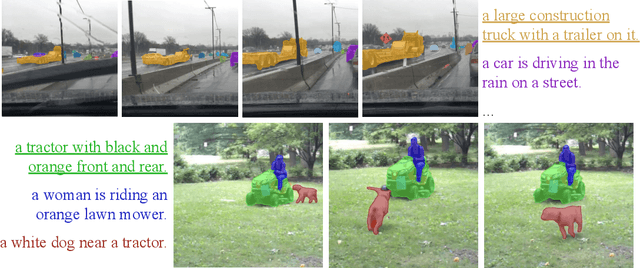Alexander G. Schwing
Studying Classifier(-Free) Guidance From a Classifier-Centric Perspective
Mar 13, 2025Abstract:Classifier-free guidance has become a staple for conditional generation with denoising diffusion models. However, a comprehensive understanding of classifier-free guidance is still missing. In this work, we carry out an empirical study to provide a fresh perspective on classifier-free guidance. Concretely, instead of solely focusing on classifier-free guidance, we trace back to the root, i.e., classifier guidance, pinpoint the key assumption for the derivation, and conduct a systematic study to understand the role of the classifier. We find that both classifier guidance and classifier-free guidance achieve conditional generation by pushing the denoising diffusion trajectories away from decision boundaries, i.e., areas where conditional information is usually entangled and is hard to learn. Based on this classifier-centric understanding, we propose a generic postprocessing step built upon flow-matching to shrink the gap between the learned distribution for a pre-trained denoising diffusion model and the real data distribution, majorly around the decision boundaries. Experiments on various datasets verify the effectiveness of the proposed approach.
Variational Rectified Flow Matching
Feb 13, 2025Abstract:We study Variational Rectified Flow Matching, a framework that enhances classic rectified flow matching by modeling multi-modal velocity vector-fields. At inference time, classic rectified flow matching 'moves' samples from a source distribution to the target distribution by solving an ordinary differential equation via integration along a velocity vector-field. At training time, the velocity vector-field is learnt by linearly interpolating between coupled samples one drawn from the source and one drawn from the target distribution randomly. This leads to ''ground-truth'' velocity vector-fields that point in different directions at the same location, i.e., the velocity vector-fields are multi-modal/ambiguous. However, since training uses a standard mean-squared-error loss, the learnt velocity vector-field averages ''ground-truth'' directions and isn't multi-modal. In contrast, variational rectified flow matching learns and samples from multi-modal flow directions. We show on synthetic data, MNIST, CIFAR-10, and ImageNet that variational rectified flow matching leads to compelling results.
LIFe-GoM: Generalizable Human Rendering with Learned Iterative Feedback Over Multi-Resolution Gaussians-on-Mesh
Feb 13, 2025



Abstract:Generalizable rendering of an animatable human avatar from sparse inputs relies on data priors and inductive biases extracted from training on large data to avoid scene-specific optimization and to enable fast reconstruction. This raises two main challenges: First, unlike iterative gradient-based adjustment in scene-specific optimization, generalizable methods must reconstruct the human shape representation in a single pass at inference time. Second, rendering is preferably computationally efficient yet of high resolution. To address both challenges we augment the recently proposed dual shape representation, which combines the benefits of a mesh and Gaussian points, in two ways. To improve reconstruction, we propose an iterative feedback update framework, which successively improves the canonical human shape representation during reconstruction. To achieve computationally efficient yet high-resolution rendering, we study a coupled-multi-resolution Gaussians-on-Mesh representation. We evaluate the proposed approach on the challenging THuman2.0, XHuman and AIST++ data. Our approach reconstructs an animatable representation from sparse inputs in less than 1s, renders views with 95.1FPS at $1024 \times 1024$, and achieves PSNR/LPIPS*/FID of 24.65/110.82/51.27 on THuman2.0, outperforming the state-of-the-art in rendering quality.
Reinforcement Learning Gradients as Vitamin for Online Finetuning Decision Transformers
Oct 31, 2024



Abstract:Decision Transformers have recently emerged as a new and compelling paradigm for offline Reinforcement Learning (RL), completing a trajectory in an autoregressive way. While improvements have been made to overcome initial shortcomings, online finetuning of decision transformers has been surprisingly under-explored. The widely adopted state-of-the-art Online Decision Transformer (ODT) still struggles when pretrained with low-reward offline data. In this paper, we theoretically analyze the online-finetuning of the decision transformer, showing that the commonly used Return-To-Go (RTG) that's far from the expected return hampers the online fine-tuning process. This problem, however, is well-addressed by the value function and advantage of standard RL algorithms. As suggested by our analysis, in our experiments, we hence find that simply adding TD3 gradients to the finetuning process of ODT effectively improves the online finetuning performance of ODT, especially if ODT is pretrained with low-reward offline data. These findings provide new directions to further improve decision transformers.
GoMAvatar: Efficient Animatable Human Modeling from Monocular Video Using Gaussians-on-Mesh
Apr 11, 2024Abstract:We introduce GoMAvatar, a novel approach for real-time, memory-efficient, high-quality animatable human modeling. GoMAvatar takes as input a single monocular video to create a digital avatar capable of re-articulation in new poses and real-time rendering from novel viewpoints, while seamlessly integrating with rasterization-based graphics pipelines. Central to our method is the Gaussians-on-Mesh representation, a hybrid 3D model combining rendering quality and speed of Gaussian splatting with geometry modeling and compatibility of deformable meshes. We assess GoMAvatar on ZJU-MoCap data and various YouTube videos. GoMAvatar matches or surpasses current monocular human modeling algorithms in rendering quality and significantly outperforms them in computational efficiency (43 FPS) while being memory-efficient (3.63 MB per subject).
OW-VISCap: Open-World Video Instance Segmentation and Captioning
Apr 04, 2024



Abstract:Open-world video instance segmentation is an important video understanding task. Yet most methods either operate in a closed-world setting, require an additional user-input, or use classic region-based proposals to identify never before seen objects. Further, these methods only assign a one-word label to detected objects, and don't generate rich object-centric descriptions. They also often suffer from highly overlapping predictions. To address these issues, we propose Open-World Video Instance Segmentation and Captioning (OW-VISCap), an approach to jointly segment, track, and caption previously seen or unseen objects in a video. For this, we introduce open-world object queries to discover never before seen objects without additional user-input. We generate rich and descriptive object-centric captions for each detected object via a masked attention augmented LLM input. We introduce an inter-query contrastive loss to ensure that the object queries differ from one another. Our generalized approach matches or surpasses state-of-the-art on three tasks: open-world video instance segmentation on the BURST dataset, dense video object captioning on the VidSTG dataset, and closed-world video instance segmentation on the OVIS dataset.
StableDreamer: Taming Noisy Score Distillation Sampling for Text-to-3D
Dec 02, 2023



Abstract:In the realm of text-to-3D generation, utilizing 2D diffusion models through score distillation sampling (SDS) frequently leads to issues such as blurred appearances and multi-faced geometry, primarily due to the intrinsically noisy nature of the SDS loss. Our analysis identifies the core of these challenges as the interaction among noise levels in the 2D diffusion process, the architecture of the diffusion network, and the 3D model representation. To overcome these limitations, we present StableDreamer, a methodology incorporating three advances. First, inspired by InstructNeRF2NeRF, we formalize the equivalence of the SDS generative prior and a simple supervised L2 reconstruction loss. This finding provides a novel tool to debug SDS, which we use to show the impact of time-annealing noise levels on reducing multi-faced geometries. Second, our analysis shows that while image-space diffusion contributes to geometric precision, latent-space diffusion is crucial for vivid color rendition. Based on this observation, StableDreamer introduces a two-stage training strategy that effectively combines these aspects, resulting in high-fidelity 3D models. Third, we adopt an anisotropic 3D Gaussians representation, replacing Neural Radiance Fields (NeRFs), to enhance the overall quality, reduce memory usage during training, and accelerate rendering speeds, and better capture semi-transparent objects. StableDreamer reduces multi-face geometries, generates fine details, and converges stably.
Offline Imitation from Observation via Primal Wasserstein State Occupancy Matching
Nov 21, 2023Abstract:In real-world scenarios, arbitrary interactions with the environment can often be costly, and actions of expert demonstrations are not always available. To reduce the need for both, Offline Learning from Observations (LfO) is extensively studied, where the agent learns to solve a task with only expert states and \textit{task-agnostic} non-expert state-action pairs. The state-of-the-art DIstribution Correction Estimation (DICE) methods minimize the state occupancy divergence between the learner and expert policies. However, they are limited to either $f$-divergences (KL and $\chi^2$) or Wasserstein distance with Rubinstein duality, the latter of which constrains the underlying distance metric crucial to the performance of Wasserstein-based solutions. To address this problem, we propose Primal Wasserstein DICE (PW-DICE), which minimizes the primal Wasserstein distance between the expert and learner state occupancies with a pessimistic regularizer and leverages a contrastively learned distance as the underlying metric for the Wasserstein distance. Theoretically, we prove that our framework is a generalization of the state-of-the-art, SMODICE, and unifies $f$-divergence and Wasserstein minimization. Empirically, we find that PW-DICE improves upon several state-of-the-art methods on multiple testbeds.
A Simple Solution for Offline Imitation from Observations and Examples with Possibly Incomplete Trajectories
Nov 02, 2023Abstract:Offline imitation from observations aims to solve MDPs where only task-specific expert states and task-agnostic non-expert state-action pairs are available. Offline imitation is useful in real-world scenarios where arbitrary interactions are costly and expert actions are unavailable. The state-of-the-art "DIstribution Correction Estimation" (DICE) methods minimize divergence of state occupancy between expert and learner policies and retrieve a policy with weighted behavior cloning; however, their results are unstable when learning from incomplete trajectories, due to a non-robust optimization in the dual domain. To address the issue, in this paper, we propose Trajectory-Aware Imitation Learning from Observations (TAILO). TAILO uses a discounted sum along the future trajectory as the weight for weighted behavior cloning. The terms for the sum are scaled by the output of a discriminator, which aims to identify expert states. Despite simplicity, TAILO works well if there exist trajectories or segments of expert behavior in the task-agnostic data, a common assumption in prior work. In experiments across multiple testbeds, we find TAILO to be more robust and effective, particularly with incomplete trajectories.
Is Generalized Dynamic Novel View Synthesis from Monocular Videos Possible Today?
Oct 12, 2023



Abstract:Rendering scenes observed in a monocular video from novel viewpoints is a challenging problem. For static scenes the community has studied both scene-specific optimization techniques, which optimize on every test scene, and generalized techniques, which only run a deep net forward pass on a test scene. In contrast, for dynamic scenes, scene-specific optimization techniques exist, but, to our best knowledge, there is currently no generalized method for dynamic novel view synthesis from a given monocular video. To answer whether generalized dynamic novel view synthesis from monocular videos is possible today, we establish an analysis framework based on existing techniques and work toward the generalized approach. We find a pseudo-generalized process without scene-specific appearance optimization is possible, but geometrically and temporally consistent depth estimates are needed. Despite no scene-specific appearance optimization, the pseudo-generalized approach improves upon some scene-specific methods.
 Add to Chrome
Add to Chrome Add to Firefox
Add to Firefox Add to Edge
Add to Edge